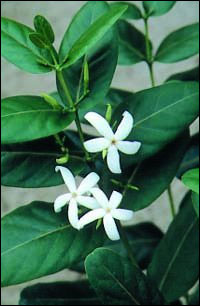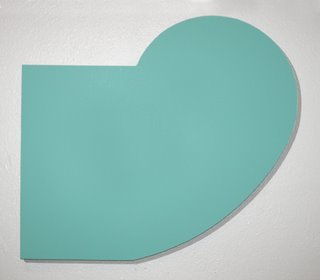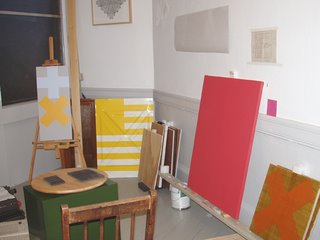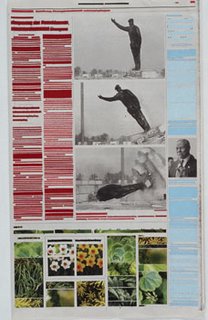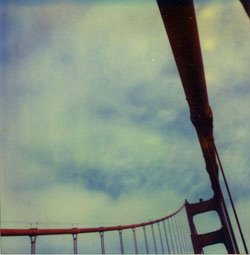Thoughts on Gone Formalism
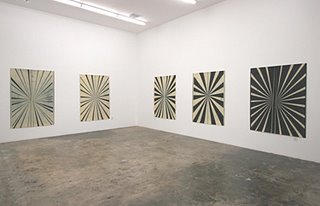 (above, 2005 installation shot of Mark Grotjahn at Blum & Poe)
(above, 2005 installation shot of Mark Grotjahn at Blum & Poe)
I went to see Gone Formalism at University of Penn’s ICA two Sundays ago, before it was, well…gone. The exhibit was nicely arranged, but I was unsure about the curatorial premise at first – largely because (in an egotistical way) I couldn’t figure it out. That is, if one criterion for “good” curating is that the premise is penetrable by a reasonably educated viewer. It eventually began making some sense to me in my own grappling with the word and concept of formalism. (Reading the exhibit essay afterwards, the curator seemed a little loosy-goosy on the premise as well.)
Regardless, I continued to ruminate on formalism while walking through the show. The word formal has always signified to me an overriding concern with the basic elements of art making: color, line, space, composition, material, etc., as opposed to more idea-based, conceptual concerns. All of the work was in some way concerned with those issues of the visual experience. Though both were in play, the bent of Gone Formalism was largely conceptual rather than literal. And when I say conceptual, I mean both within the pieces themselves as well as among them – in the joints that held this body of work together.
For example, Jessica Jackson Hutchins’ White Mountain – a leaning, icy ski-slope of a sculpture – is really a façade covering its true source, which cannot be seen until moving to the opposite side. Doing so, we find the structure is built of a material that is the epitome of ephemeral – papier-mâché of newspaper. There is a shock here of the elemental, when set into contrast with its intrinsic opposite, the farce. And yet the foolery is grand; the formal aspects pump life into the concept and its irony. (This foolery is turned on itself in another piece, The Philosopher’s Stone; again of papier-mâché, but in this case with embedded, real pyrite – fool’s gold). The whole thing has a curiously tipsy whimsy, which only increases its appeal – somewhat akin to the glee imparted by a model railroad’s paper mountains. The formal source (paper) is evident in this piece, as well as the formal product (fake mountain), but having been melded in this way, they become conceptually valid and inseparable. Perhaps I have stumbled upon an accidental definition of art itself: source + product = art. Or maybe not.
http://www.derekeller.com/jessicahutchins_work.html
Elemental almost equated formal in this show. I also found that concept and form were in cahoots…sometimes towards somewhat sketchy aims. Nonetheless, the formalities of Gone Formalism were continually exposing, revealing and examining the core elements of artistic construction – in both a conceptual and a literal (tangible/material) sense. Elemental became a clarification of formalism.
A further example of this was the so-called Butterfly drawings and paintings by Mark Grotjahn. They are beautifully executed with tightly-packed lines, often black, white or red, radiating multi-directionally from a central line or lines to the edges of the surface, creating the sense of a Suprematist angel. Their actual genesis is exposed: the vertical flat-line(s) from which each of them begins to take shape, or flight – where the form transmogrifies. How appropriate then, that they are called butterflies. We see the product, and the conceptual creature that has emerged from this chrysalis line of the works’ formalities has made this relationship, if not clear, clearer. www.blumandpoe.com/artists/markgrotjahn/2005/index.htm
In Gitte Schafer’s work, this formal relationship between source and product takes an interesting twist. Her pieces, constructed of found objects such as floor lampposts, baskets and plastic dishes and arranged in copses on the gallery floor, are curiously totem-like. Interestingly enough, the source and product seem to be one and the same here, in a strangely self-generated way. It seems this work only needed a pair of mortal hands to allow them to escape. This thought reminded me of the story said of Michelangelo, who was supposed to have seen the future sculpture trapped in the marble chunk, only needing to “let it out”. In Schafer’s pieces, indeed in the entire installation, the work itself is the formality. The formalism is pure, seemingly revealed rather than created.
http://www.perryrubenstein.com/home.html (click on Schafer's link on main page).
The formalism in Liz Larner’s work, especially her mixed media cubist sculptures, is not only found in the elements of the piece itself – shape and color – or even the previous artist’s work, whose color schemes she lifts and reapplies to her pieces: it’s a strange and fascinating hybrid of both. The formal elements exist in all three spheres: the past, the present, and the future of their connection – which, of course, is always becoming present. That is, the pieces are floating in an odd formalistic space that is between source and product; concept and realization. This sense is heightened by Larner’s adoption of a molecular style – simultaneously grounded and tenuous – which speaks of elemental typologies. www.303gallery.com/artists/larner
Formalism, then, in this exhibit, was indeed “gone”, in the sense that it was far beyond that term’s traditional parameters. Indeed, much of the work was in a foggy, alluring space of questioning, exuding the tension of potential energy instead of the jaunty kinetic. The formal aspects of the curating were somewhat dry, but luckily the formal envelope-pushing of the work largely saved the premise from itself.
Read more...